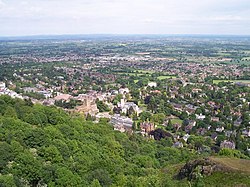The Worcestershire portal

| |
Worcestershire (/ˈwʊstərʃər/ ⓘ WUUST-ər-shər, /-ʃɪər/ -sheer; written abbreviation: Worcs) is a ceremonial county in the West Midlands of England. It is bordered by Shropshire, Staffordshire, and the West Midlands county to the north, Warwickshire to the east, Gloucestershire to the south, and Herefordshire to the west. The city of Worcester is the largest settlement and the county town.
The county is largely rural, and has an area of 1,741 km2 (672 sq mi) and an estimated population of 609,216 in 2022. After Worcester (103,872) the largest settlements are Redditch (87,036), Kidderminster (57,400), and Bromsgrove (34,755). It contains six local government districts, which are part of a two-tier non-metropolitan county also called Worcestershire. The county historically had complex boundaries, and included Dudley and the southwestern suburbs of Birmingham.
The River Severn flows through the centre of the county from north to south, forming a wide plain. The southwest of the county contains part of the Malvern Hills, a National Landscape which contains Worcestershire Beacon, at 425 m (1,394 ft) the county's highest point. The southeast contains a small part of the Cotswolds, and in the northwest is part of the Wyre Forest, a national nature reserve.
There is some evidence of Roman occupation in Worcestershire; the area later became part of the Anglo-Saxon kingdom of Hwicce, and then Mercia. Worcestershire was constituted as a county around 927, as the Kingdom of England formed. During the High Middle Ages the county was the site of the Battle of Evesham, in which Simon de Montfort was defeated, and in 1651 the Battle of Worcester was the last major engagement of the Wars of the Three Kingdoms. During the Industrial Revolution the north of the county was part of the Black Country, a major manufacturing centre, Kidderminster became famous for carpet production, and Worcester for porcelain. (Full article...)
The battle of Powick Bridge was a skirmish fought on 23 September 1642 south of Worcester, England, during the First English Civil War. It was the first engagement between elements of the principal field armies of the Royalists and Parliamentarians. Sir John Byron was escorting a Royalist convoy of valuables from Oxford to King Charles's army in Shrewsbury and, worried about the proximity of the Parliamentarians, took refuge in Worcester on 16 September to await reinforcements. The Royalists despatched a force commanded by Prince Rupert. Meanwhile, the Parliamentarians sent a detachment, under Colonel John Brown, to try to capture the convoy. Each force consisted of around 1,000 mounted troops, a mix of cavalry and dragoons. (Full article...)
List of Featured articles
|
|---|
General images
Malvern (/ˈmɔːlvərn, ˈmɒl-/, locally also: /ˈmɔːvərn/) is a spa town and civil parish in Worcestershire, England. It lies at the foot of the Malvern Hills, a designated Area of Outstanding Natural Beauty. The centre of Malvern, Great Malvern, is a historic conservation area, which grew dramatically in Victorian times due to the natural mineral water springs in the vicinity, including Malvern Water.
At the 2021 census it had a population of 30,462. It includes Great Malvern on the steep eastern flank of the Malvern Hills, as well as the former independent urban district of Malvern Link. Many of the major suburbs and settlements that comprise the town are separated by large tracts of open common land and fields, and together with smaller civil parishes adjoining the town's boundaries and the hills, the built up area is often referred to collectively as The Malverns. (Full article...)
List of Good articles
|
|---|
Selected quotes
| “ | The top three hardest things to say are:
|
” |
- — Unknown
Did you know?

- ...that Simon de Montfort was killed and had his testicles cut off at the Battle of Evesham (pictured)?
- ...that Whittington Tump in Worcestershire was the site of a motte castle?
- ...that the investigation into the murder of Céline Figard saw the UK's first national DNA screening programme in the hunt for a suspect?
- ...that the medieval nobleman Walter de Beauchamp was granted the right to keep pheasants on his lands and fine any who poached them by King Henry I of England?
Things you can do for WikiProject Worcestershire
WORCS/ToDo is a list of urgent tasks. If they have been addressed, please do not remove them from the list, but check them off with the {{done}} (![]() Done) template, and sign your name with four tildes: ~~~~ (Full article...)
Done) template, and sign your name with four tildes: ~~~~ (Full article...)
Categories
Related WikiProjects
| WikiProject Cities WikiProject UK geography WikiProject England |
West Midlands
Warwickshire Gloucestershire (inactive) Herefordshire (low activity) Shropshire (low activity) Staffordshire (no project yet) |
WikiProject UK Railways WikiProject UK Roads WikiProject UK Waterways WikiProject UK Trams |
Berkshire
Cambridge Cheshire Cornwall Derbyshire Devon Dorset Greater Manchester Hampshire Hertfordshire Kent Lancashire and Cumbria Lincolnshire London Merseyside North East England Northamptonshire Nottinghamshire Somerset Surrey Sussex Warwickshire West Midlands Wight Worcestershire Yorkshire |
|---|
Related Portals
Religions here
British Isles
Associated Wikimedia
The following Wikimedia Foundation sister projects provide more on this subject:
-
Commons
Free media repository -
Wikibooks
Free textbooks and manuals -
Wikidata
Free knowledge base -
Wikinews
Free-content news -
Wikiquote
Collection of quotations -
Wikisource
Free-content library -
Wikiversity
Free learning tools -
Wikivoyage
Free travel guide -
Wiktionary
Dictionary and thesaurus
















































































































